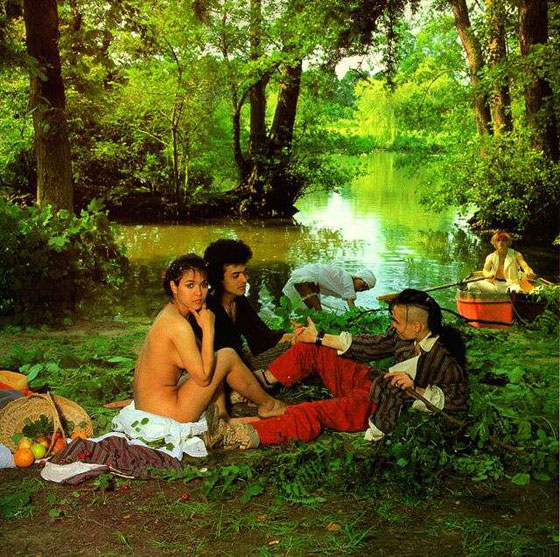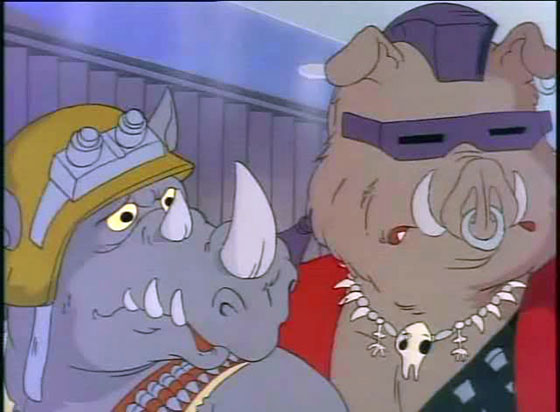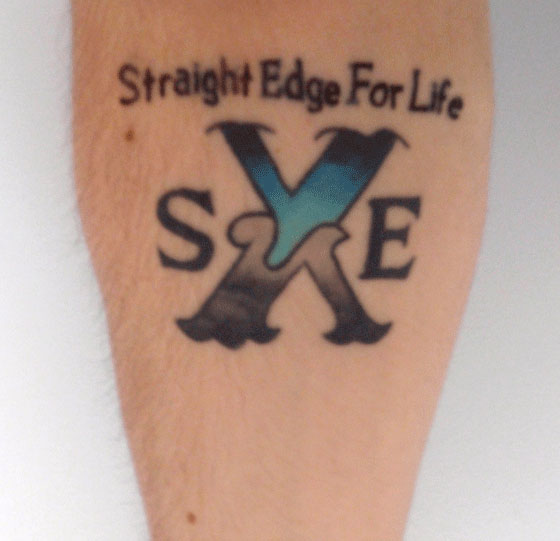|
|
| Revolutions per minute Kaspars Groševs, Artist | |
| Two threes are rotating around an axis. The longer they are spinning, the less they look like figures, twisting and dissolving as they move. Two threes spin around the axis thirty three times per minute, and along with them there wobbles and ripples one more third and three small letters – RPM (Revolutions per minute). For a Latvian mind like the one I have, the letters standing for revolutions per minute make me first of all think of fundamental changes in power per minute. How many revolutions are there really per minute? To be more exact, how many fundamental changes are supported by a thought or action per minute? Maybe somewhere someone is drawing three lines on squared paper, lines that are later to become an international event, while elsewhere one more breakfast fortifies a personal commitment to do away with cheese with holes in it, once and forever. | |
 The band’s Bow Wow Wow record covers See Jungle! See Jungle! Go Join Your Gang, Yeah. City All Over! Go Ape Crazy Publicity photo | |
| Long-playing vinyl records are still played at 33.33 RPM, but their manufacturers will certainly remember the time when a cassette player was part of the stockpile of sound gear in people’s bedrooms, lounge rooms and kitchens. People were able to record music from the radio, copy and share recordings with friends, acquaintances and strangers. With the help of a pencil, you could wind up the time captured in the tape. In 1980, Annabella Lwin, dressed up as a pop-music pirate, repeated in a strident voice the words written by the godfather of punk music, Malcolm McLaren: “C30, C60, C90, go!” The song in Burundi beat eulogized the most popular cassette formats of the day and at the same time, and to a certain extent, marked a flagging of the initial rapture in the punk revolution, but let us return to that later. C90 meant that a cassette could hold approximately two long-playing records (2x45 minutes), and all of a sudden time was slightly easier to take hold of. Thirty years later it is so difficult to imagine any limits to data carriers that even the Guinness Book of Records no longer thinks it worth maintaining the category of “The World’s Longest Album”. And Nam June Paik, possibly, would be forced to admit that books have ceased to be “the most advanced technology”.(1) The punk coup in the UK was launched by the word “shit!”, scornfully spat out live on TV. Upon Malcolm McLaren’s solicitous advice, the boutique of his girlfriend, Vivienne Westwood, acquired a new name – SEX, and a timeless accessory: the band Sex Pistols. The punk revolution had already started, but the expletives the Sex Pistols members uttered on Bill Grundy’s afternoon TV show in 1976 echoed the next day from the front pages of British papers (“The Filth and the Fury!”), and straight away also in the minds of anxious parents, lunch-time conversations and scratchiti on public transport seats. The word “punk” was, and still is, protected and cared for with pride by its keepers. It was in angry slogans that they found their identity, to be enhanced by squeaky guitars and the rebellion manifested in their clothing. Multicoloured mohawks cut through the crowds like festive banners in the streets of London, Liverpool and Manchester, soon to spread from Paris to Moscow and beyond. When, in the late 1970s, Derek Jarman’s film Jubilee appeared on the screen, Vivienne Westwood offered her customers an open letter of denunciation to the director: “I had been to see it once and thought it the most boring and therefore disgusting film I had ever seen” said the wobbly handwriting of the letter printed on a T-shirt. | |
 Bebop and Rocksteady in the animated series Ninja Turtles Publicity photo | |
| It seemed to Westwood that in this work, promoted as the first punk film, the street subculture had been used as stage design, giving the wrong impression about punks. A culture invoking anarchy and freedom was suddenly threatened by a homosexual film director from “artistic circles”, offering his version about a certain time in a certain place. Shortly before his death, Jarman wrote that the film had later turned out to be prophetic. Many of the original anarchists were soon basking on TV in Top of the Pops, while Adam Ant, one of the lead actors in Jubilee, entertained soldiers at a ball celebrating the victory of the British (and Margaret Thatcher) in the Falklands War. In 1863, Édouard Manet’s painting Le Déjeuner sur l’herbe (‘The Luncheon on the Grass’) sparked the displeasure of the Parisian public. The picture features two respectably clad gentlemen who have sat down in rather roughly daubed woods, together with a nude lady gazing serenely at the viewer. The men, lost in conversation, scarcely notice her, just like they ignore the woman clad in a nightdress who is bathing in a nearby river or lake. Manet’s uneven strokes were re-echoed ten years later in the newspaper Le Charivari, with Louis Leroy sarcastically satirising a bunch of – in his opinion – inept Parisian painters. And thus the mocked-at Impressionists were drawn into the modernist whirlpool. More than a hundred years later, The Luncheon on the Grass shocked society once again. This time Annabella Lwin, at the time a 15-year-old babe, joined in the meal, with her mates from the band Bow Wow Wow posing in the roles of the city dandies. The not-too-precise photographic interpretation of Manet’s painting was to be used for the cover of their album See Jungle! See Jungle! Go Join Your Gang, Yeah. City All Over! Go Ape Crazy. The young singer’s mother, meanwhile, sued Malcolm McLaren for the exploitation of a minor. Bow Wow Wow was Malcolm McLaren’s next “project” after the punk revolution, a weird attempt to destroy the music industry from the inside, using to this end the underage Annabella, lewd lyrics and a whole load of erotic photographs. Managing the Sex Pistols had finished in massive disagreement, the breakup of the group and – finally – the death of the notorious bassist Sid Vicious. But McLaren’s plan to stir up a nationwide paedophilia scandal by publishing, with financial assistance from the music giant EMI, a kids porn magazine called Chicken, again featuring Annabella Lwin, failed. Punk rock had become too slow. Lydia Lunch, “the official face” of the New York No Wave movement, was to sneer some time later: “I thought punk was lousy Chuck Berry music amped up to play triple fast. (..) I thought it was really too much orientated towards fashion.”(2) Lunch’s howls, clusters of booming noises and screaming wails of saxophone that tore the air in New York artists’ dives had finally decimated rock music, leaving behind a mutilated carcass. Although the No Wave overthrow took place mostly on the cover of the No New York vinyl record while its participants maintained obstinate silence, foregoing slogans and grandiose future plans, it rumbled on like a thunderstorm in summer, making many sit up. While Jean-Michel Basquiat was rubbing shoulders with crowds at the concerts of Lydia Lunch and her group, Teenage Jesus and the Jerks, in the west, east, south, north and centre of America the hollow rumble reverberated in furious incitements and piercing vibrations of guitar strings. Young and angry, keepers of the punk legacy offered a new version of mutiny and anarchy – hardcore punk, alluding to the term used by the porn industry to denote heavy porn. The hardcore version of punk rock was uncontrollable, like a vein throbbing on one’s neck, with music crashing through clapped-out loudspeakers as fast as the drummer’s extremities would allow. In the mid-1980s, mutant monsters, named after bebop and rocksteady genres of music, scared the kids from TV screens. Loaded with chains, wearing military style clothes and brightly coloured mohawks, mutant punks fought ninja turtles in the New York City underground. For the most part unsuccessfully. The ninjas, in turn, were being cheered on by one of the 80s mainstream rappers, Vanilla Ice, with a spirited Go ninja, go ninja, go!. The clashes of subcultures had entered into popular culture, thus obtaining many of the stereotypes we know today. In the city slums, aggressive punks wallowed in garbage, the hip-hop culture left behind it defaced walls, while antisocial Goths pined away in basements, messing around with the occult. “A brain, a beauty, a jock, a rebel and a recluse. Before the day was over, they broke the rules (...)”(3) While Soviet children were being scared by a hippie wolf with a cigarette in its mouth, American television screens were lit up by Ronald Reagan’s smile, but the punk rock in stale cellars and beer-soaked bars had become much faster and more violent. People’s bodies rolled over the edge of the stage and band members sometimes mingled with the crowd in order to have a punch up. Hardcore music embodied young people’s protest against the existing division of roles and became the soundtrack for the mood of a certain stratum of society. Amidst the flailing feet, hands and hair, Jello Biafra yelled, with a TV evangelist’s tremor in his voice: “I’m your hope dope pusher!” | |
 Typical hardcore tattoo signifying a commitment to abstain from intoxicating substances by its wearer Foto no publicitātes materiāliem / | |
| I remember how, round about the time when conductors had just appeared on public transport in Riga, an elderly bus conductor expressed her horror about my friends’ pierced ears, lips, eyebrows and noses. To which somebody replied, with a snigger, that their god was a magnet – the more metal in your body, the closer you are to the almighty. The number of bands and small independent music publishers grew in proportion to the number of broken jaws. Information travelled from town to town via records, cassettes and home-edited numbers, slowly building a definite community where information circulates like well-lubricated conversation. During a longer communication, the words accumulated meaning; to an outside observer they seemed like sentences dropped in a hurry. A commonplace word or simply the geometry of eyebrows allowed a person conversant with the language to continue with a communication in which pieces of clothing, graphic signs and tattoo lines have their place. As in similar subcultures, the language of communication in hardcore communities remained, for as long as possible, as opaque as any ‘insider joke’ that is funny only for those in the know. Like before, the punks of the 1970s inevitably felt weary – from the shards of glass under their feet, from the incessant brawls, the conflicts with the law, an abstract enemy and the monotonous beat of the music. A community that still nurtured a vision of independence from the state system tried to absorb bloody fists and the owners thereof, fierce individuals for whom a comrade’s shoulder served as a catalyst for violence. Hardcore subculture slowly went through change, with many of its original adherents growing up and getting tired of destruction and roaming around (Seek & Destroy). As they fought unsuccessfully to avert the imminent capitulation through indelible individual promises of their flesh, time inevitably pointed towards new uprisings. Sitting alone with the rumble of Riga trains, nothing can be stated with any certainty, however, doubt and revelations began to creep into the recordings emerging from the punk community in the mid-1980s. Collectors of music stories will later credit this time with being the starting point for a number of genres, but they too will hardly be able to say that for certain. New events unfolded at every moment. Possibly at some point the punk community had very little left in common with those drunkards who a decade earlier had styled their hair with beer and burnt the flag of their country. The ecstasy of negation is followed by a stage when slogans should be put into practice, and perhaps doing things had left a bitter aftertaste. And all at once the punks were so miserable as to tell you everything. The name Emo, from the very first day detested by the ones who were called this, slipped out of somebody’s mouth as inadvertently as that which was once uttered by Louis Leroy. In twenty years’ time, emo was already a global movement with its own language and rules. As a quiet reply to the increasing dominance of hooligans at concerts and the predictable musical algorithms, emo (from the word emotional) punk rock began to drown in longing and visions. Somewhere, the still existent authority sneered menacingly, and emo seemed to say: “It is difficult for me to fight all that on my own.” After 1991, when the Western world was shaken by Nevermind, a record by Nirvana, the movers and shakers of the music industry seemed to suddenly realise that hysterical yelling and a hatred of yourself and those around you can be sold. The next year saw the screening of the film Wayne’s World, which features two no-hoper metalheads unexpectedly ensnared by a greedy media corporation. Although this flirtation turns out to be a failure, and the characters learn the meaning of “selling yourself”, the movie has a happy end: the scruffy rebels come under the care of a “good” corporation and live happily ever after. Wayne, the one whose world is depicted in the film, finally gets his Filipino dream girl, whose looks and musical career in the film strangely resemble the case of Annabella Lwin. You would have thought that with the weapon lent to Cobain by Dylan Carlson everything should have come to an end, but still that was not the case. By the time those who fought against music piracy had become alarmed by developments in computer technology which allowed time to be grasped even more firmly than on cassette, alternative rock had blown up. Grunge had ceased to be something that young people played somewhere in Seattle – even in the little houses of godforsaken Limbaži, decrepit guitars were being tuned to repeat the magical chords of “Come as you are”. The bewailings of sad losers were burnt into thousands of CDs. It turned out that everybody was having a hard time – both the hooligans and their pretty girlfriends as well as the geeks and the loners. Punk rock had become the soundtrack for a high school get together, where all of the above have gathered to smoke marihuana on the school football grounds, trying to forget about the decade into which they had landed against their will. In 1895, Swedish writer and painter August Strindberg refused Gauguin’s request that he write a preface to the exhibition catalogue, saying in his letter, among other things: “I cannot understand your art and I cannot like it. I have no grasp of your art, which is now exclusively Tahitian. But I know that this confession will neither astonish nor wound you, for you always seem to me fortified especially by the hatred of others (..) For moment you were approved and admired and had supporters, they would classify you, put in your place and give your art a name which, five years later, the younger generation would be using as a tag for designating a superannuated art, and art they would do everything to render still more out of date.”(4) Translator into English: Sarmīte Lietuviete (1) In 1978, six symposia were held on the concepts of time and place in music and visual art, with the participation of Nam June Paik, John Cage and Merce Cunningham. In the video of the first symposium the Korean artist says, among other things: “Video tape has sequential access, books are random access. That’s why books are still the most advanced technology (..).” www.ubu.com/film/cunningham_time.html (2) Gross, Jason. Interview with Lydia Lunch. Perfect Sound Forever, October 1997. www.furious.com/perfect/lydialunch.html (3) Introduction from the trailer for 1985 cult film, The Breakfast Club. (4) Browning Chipp, Herschel. Theories of modern art: a source book by artists and critics. California: University of California Press, 1968, p. 83. | |
| go back | |







